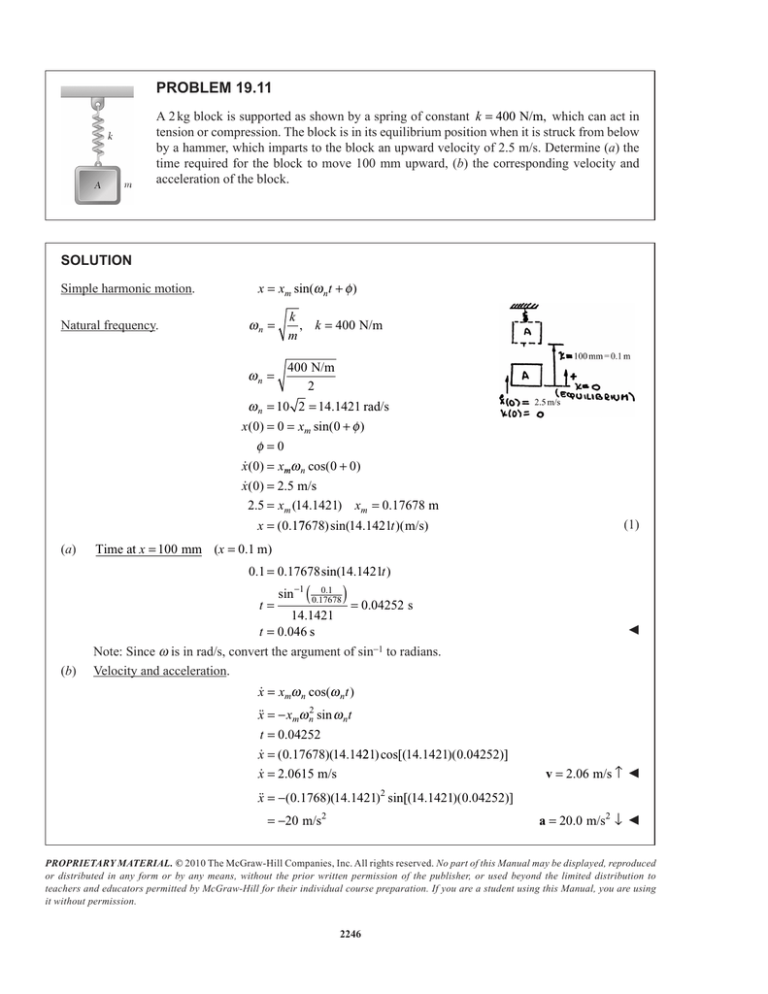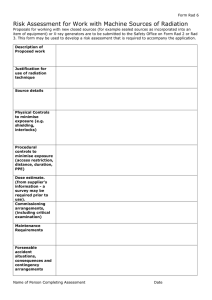
PROBLEM 19.11
A 2 kg block is supported as shown by a spring of constant k = 400 N/m, which can act in
tension or compression. The block is in its equilibrium position when it is struck from below
by a hammer, which imparts to the block an upward velocity of 2.5 m/s. Determine (a) the
time required for the block to move 100 mm upward, (b) the corresponding velocity and
acceleration of the block.
Solution
Simple harmonic motion.
Natural frequency.
x = xm sin(w nt + f )
wn =
k
, k = 400 N/m
m
wn =
400 N/m
2
w n = 10 2 = 14.1421 rad/s
x(0) = 0 = xm sin(0 + f )
f=0
x (0) = xmw n cos( 0 + 0)
x (0) = 2.5 m/s
(a)
2.5 = xm (14.1421) xm = 0.17678 m
x = (0.17678)sin(14.1421t )( m/s) (1)
Time at x = 100 mm (x = 0.1 m)
0.1 = 0.17678 sin(14.1421t )
t=
(b)
sin -1
0.1
( 0.17678
) = 0.04252 s
14.1421
t = 0.046 s
Note: Since w is in rad/s, convert the argument of sin-1 to radians.
Velocity and acceleration.
b
x = xmw n cos(w nt )
x = - xmw n2 sin w nt
t = 0.04252
x = (0.17678)(14.14221) cos[(14.1421)(0.04252)]
x = 2.0615 m/s
v = 2.06 m/s ≠ b
2
x = -(0.1768)(14.1421) sin[(14.1421)(0.04252)]
= -20 m/s2
a = 20.0 m/s2 Ø b
PROPRIETARY MATERIAL. © 2010 The McGraw-Hill Companies, Inc. All rights reserved. No part of this Manual may be displayed, reproduced
or distributed in any form or by any means, without the prior written permission of the publisher, or used beyond the limited distribution to
teachers and educators permitted by McGraw-Hill for their individual course preparation. If you are a student using this Manual, you are using
it without permission.
2246
PROBLEM 19.16
A small bob is attached to a cord of length 1.2 m and is released from rest when
θ A = 5°. Knowing that d = 0.6 m, determine (a) the time required for the bob
to return to Point A, (b) the amplitude θC .
SOLUTION
As the pendulum moves between Points A and B, the length of the pendulum is l = l AB = 1.2 m.
ωn = ωn1 =
τ1 =
2π
ωn1
=
g
l AB
=
9.81 m/s 2
= 2.8592 rad/s
1.2 m
2π
= 2.1975 s
2.8592 rad/s
The falling from A to B is one quarter period.
τ AB =
1
τ1 = 0.54938 s.
4
As the pendulum moves between Points B and C, the length of the pendulum is
l = lBC = 1.2 m − 0.6 m = 0.6 m.
ωn = ωn 2 =
τ2 =
g
lBC
=
9.81 m/s 2
= 4.0435 rad/s
0.6 m
2π
2π
=
= 1.55389 s
ωn2 4.0435 rad/s
The motion from B to C and back to B is one half period
τ BCB =
1
τ 2 = 0.77695 s
2
As the pendulum moves from B to A, the length is again 1.2 meters.
τ BA =
(a)
1
τ1 = 0.54938 s
4
Time required to return to A.
τ = τ AB + τ BCB + τ BA
τ = 1.87571 s
τ = 1.876 s
PROPRIETARY MATERIAL. © 2013 The McGraw-Hill Companies, Inc. All rights reserved. No part of this Manual may be displayed,
reproduced or distributed in any form or by any means, without the prior written permission of the publisher, or used beyond the limited
distribution to teachers and educators permitted by McGraw-Hill for their individual course preparation. If you are a student using this Manual,
you are using it without permission.
2253
PROBLEM 19.16 (Continued)
For falling from A to B,
θm = θ A
At B,
θB = θm = ωn1θ A
vB = l ABθB = l ABωn1θ A
For rising from B to C,
vB l AB
=
ωn1θ A = θmax
lBC lBC
l ω
θ
θC = θ max = max = AB n1 θ A
ωn 2 lBC ωn 2
θB =
θC =
(b)
(1.2 m)(2.8592 rad/s)
θ A = 1.4142 θ A
(0.6 m)(4.0435 rad/s)
Amplitude θC :
With θ A = 5°,
θC = 7.07°
PROPRIETARY MATERIAL. © 2013 The McGraw-Hill Companies, Inc. All rights reserved. No part of this Manual may be displayed,
reproduced or distributed in any form or by any means, without the prior written permission of the publisher, or used beyond the limited
distribution to teachers and educators permitted by McGraw-Hill for their individual course preparation. If you are a student using this Manual,
you are using it without permission.
2254
PROBLEM 19.37
The uniform rod shown has mass 6 kg and is attached to a
spring of constant k = 700 N/m. If end B of the rod is depressed
10 mm and released, determine (a) the period of vibration,
(b) the maximum velocity of end B.
SOLUTION
k = 700 N/m
W = mg
F = k ( x + δ st )
where
= k (0.5θ + δ st )
ma = mr α = 6(0.1 m)θ = 0.6θ
1
(6)(0.8 m)2 θ
12
= 0.32θ
Iα =
(a)
Equation of motion.
ΣM C = I α + mad : W (0.1 m) − F (0.5 m) = I α + ma (0.1 m)
W (0.1) − k (0.5θ + δ st )(0.5 m) = 0.32θ + 0.6θ(0.1)
But in equilibrium, we have
Thus,
W (0.1 m) − kδ st (0.5 m) = 0
−k (0.5)2 θ = [0.32 + 0.06]θ
−(700 N/m)(0.5)2 θ = 0.38θ
θ + (460.53)θ = 0
PROPRIETARY MATERIAL. © 2013 The McGraw-Hill Companies, Inc. All rights reserved. No part of this Manual may be displayed,
reproduced or distributed in any form or by any means, without the prior written permission of the publisher, or used beyond the limited
distribution to teachers and educators permitted by McGraw-Hill for their individual course preparation. If you are a student using this Manual,
you are using it without permission.
2278
PROBLEM 19.37 (Continued)
Natural frequency and period.
ωn2 = 460.53
ωn = 21.46 rad/s
2π
2π
τ=
=
ωn 21.46 rad/s
(b)
At end B.
τ = 0.293 s
xm = 0.010 m
vm = xmωn
= (10 mm)(21.46 rad/s)
= 214.6 mm/s
vm = 0.215 m/s
PROPRIETARY MATERIAL. © 2013 The McGraw-Hill Companies, Inc. All rights reserved. No part of this Manual may be displayed,
reproduced or distributed in any form or by any means, without the prior written permission of the publisher, or used beyond the limited
distribution to teachers and educators permitted by McGraw-Hill for their individual course preparation. If you are a student using this Manual,
you are using it without permission.
2279
PROBLEM 19.57
A 20-kg uniform square plate is suspended from a pin located
at the midpoint A of one of its 0.4 m edges and is attached to
springs, each of constant k = 1.6 kN/m If corner B is given a
small displacement and released, determine the frequency of
the resulting vibration. Assume that each spring can act in
either tension or compression.
Solution
a = q
b
b
at = a - q
2
2
sin q ª q
2
+
Equation of motion.
b
Ê bˆ
SM 0 = S ( M 0 )eff : - mg q + 2kb2q = I a + Á ˜ ma
Ë 2¯
2
2
1
b2 5
Ê bˆ
I + m Á ˜ = mb2 + m = mb2
Ë 2¯
6
4 12
Data:
b
5
ˆ
Ê
mb2q + Á mg + 2kb2 ˜ q = 0
¯
Ë
12
2
Ê 12 g 24k ˆ
+
q + Á
q =0
Ë 10 b 5m ˜¯
b = 0.4 m; m = 20 kg
k = 1.6 kN/m = 1600 N/m
È (12)(9.81) (24)(1600) ˘
q + Í
+
q =0
(5)(20) ˙˚
Î (10)(0.4)
q + 413.43 = 0
w n2 = 413.43 w n = 20.333 rad/s
Frequency.
fn =
w n 20.333
=
2p
2p
f n = 3.24 Hz b
PROPRIETARY MATERIAL. © 2010 The McGraw-Hill Companies, Inc. All rights reserved. No part of this Manual may be displayed, reproduced
or distributed in any form or by any means, without the prior written permission of the publisher, or used beyond the limited distribution to
teachers and educators permitted by McGraw-Hill for their individual course preparation. If you are a student using this Manual, you are using
it without permission.
2311
PROBLEM 19.59
A 3-kg slender rod is suspended from a steel wire which is known to
have a torsional spring constant K = 2.25 N ◊ m/rad. If the rod is rotated
through 180° about the vertical and released, determine (a) the period of
oscillation, (b) the maximum velocity of end A of the rod.
Solution
Equation of motion.
K
SM G = S ( M G )eff : - Kq = I q q + q = 0
I
K
2
2
q + w nq = 0 w n =
I
Data:
m = 3 kg
l = 200 mm = 0.2 m
1
1
2
I = ml 2 = (3) (0.2)
12
12
= 0.01 kg ◊ m2
K = 2.25 N ◊ m/ rad
2.25
= 225
0.01
w n = 15 rad/s
w n2 =
(a)
Period of oscillation.
Simple harmonic motion:
tn =
2p 2p
=
w n 15
t n = 0.419 s b
q = q m sin (w nt + j )
q = w q cos (w t + j )
n m
qm = w nq m
n
l
1
( v A )m = qm = lw Aq m
2
2
q m = 180∞ = p radians
(b)
Maximum velocity at end A.
Ê 1ˆ
( v A )m = Á ˜ (0.2)(15)(p ) Ë 2¯
( v A )m = 4.71m/s b
PROPRIETARY MATERIAL. © 2010 The McGraw-Hill Companies, Inc. All rights reserved. No part of this Manual may be displayed, reproduced
or distributed in any form or by any means, without the prior written permission of the publisher, or used beyond the limited distribution to
teachers and educators permitted by McGraw-Hill for their individual course preparation. If you are a student using this Manual, you are using
it without permission.
2314
PROBLEM 19.69
A 1.8-kg collar A is attached to a spring of constant 800 N/m and can slide
without friction on a horizontal rod. If the collar is moved 70 mm to the
left from its equilibrium position and released, determine the maximum
velocity and maximum acceleration of the collar during the resulting motion.
SOLUTION
Datum at 1:
Position 1
T1 = 0
V1 =
1 2
k xm
2
Position 2
1 2
mv2
2
xm = ωn xm
T2 =
T1 + V1 = T2 + V2
1 2 1
kxm = mωn2 xm2
2
2
ωn2 = 444.4 s −2
V2 = 0
v2 = xm
1 2 1 2
kxm = mxm + 0
2
2
k 800 N/m
ωn2 = =
m
1.8 kg
0+
ωn = 21.08 rad/s
xm = ωn xm = (21.08 s−1 )(0.070 m)
xm = 1.476 m/s
xm = ωn2 xm = (21.08 s−2 )(0.070 m)
xm = 31.1 m/s2
PROPRIETARY MATERIAL. © 2013 The McGraw-Hill Companies, Inc. All rights reserved. No part of this Manual may be displayed,
reproduced or distributed in any form or by any means, without the prior written permission of the publisher, or used beyond the limited
distribution to teachers and educators permitted by McGraw-Hill for their individual course preparation. If you are a student using this Manual,
you are using it without permission.
2330



